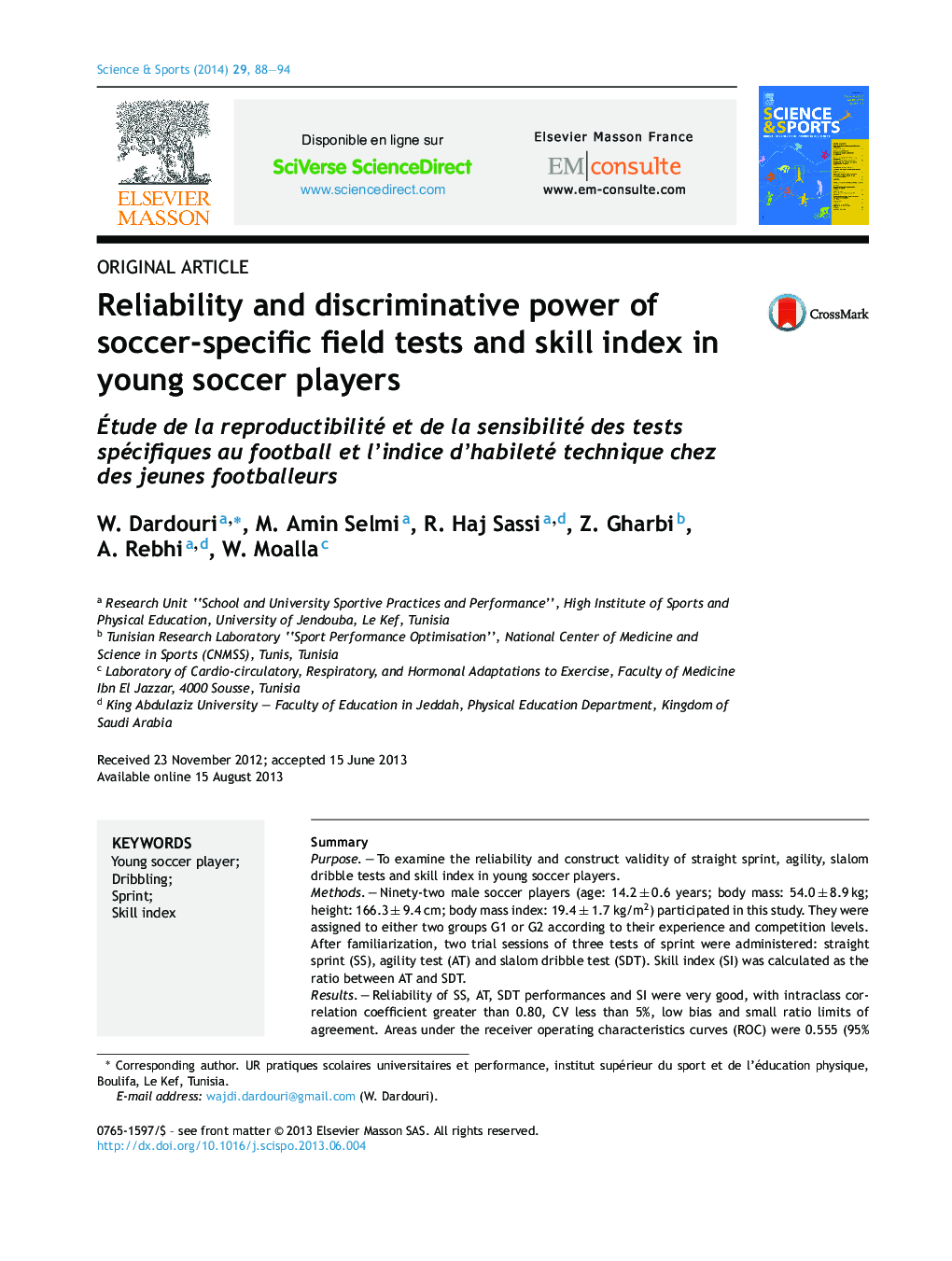| کد مقاله | کد نشریه | سال انتشار | مقاله انگلیسی | نسخه تمام متن |
|---|---|---|---|---|
| 4093054 | 1268285 | 2014 | 7 صفحه PDF | دانلود رایگان |
SummaryPurposeTo examine the reliability and construct validity of straight sprint, agility, slalom dribble tests and skill index in young soccer players.MethodsNinety-two male soccer players (age: 14.2 ± 0.6 years; body mass: 54.0 ± 8.9 kg; height: 166.3 ± 9.4 cm; body mass index: 19.4 ± 1.7 kg/m2) participated in this study. They were assigned to either two groups G1 or G2 according to their experience and competition levels. After familiarization, two trial sessions of three tests of sprint were administered: straight sprint (SS), agility test (AT) and slalom dribble test (SDT). Skill index (SI) was calculated as the ratio between AT and SDT.ResultsReliability of SS, AT, SDT performances and SI were very good, with intraclass correlation coefficient greater than 0.80, CV less than 5%, low bias and small ratio limits of agreement. Areas under the receiver operating characteristics curves (ROC) were 0.555 (95% CI: 0.448–0.659), 0.851 (95% CI: 0.762–0.917), 0.913 (95% CI: 0.836–0.962) and 0.629 (95% CI: 0.522–0.727) for SS, AT, SDT and SI, respectively.ConclusionsResults demonstrated that the three tests and SI were reliable but only AT, SDT and SI could discriminate between the levels of players’ ability. They could be used for soccer-specific skills assessments and selection process of young soccer players.
RésuméObjectifsÉtudier la reproductibilité et la sensibilité des tests de sprint, d’agilité, de dribble et de l’indice technique des jeunes footballeurs.MéthodesQuatre-vingt-douze footballeurs (âge : 14,2 ± 0,6 ans ; masse corporelle : 54,0 ± 8,9 kg ; taille : 166,3 ± 9,4 cm ; indice de masse corporelle : 19,4 ± 1,7 kg/m2) ont participé à cette étude. Ils ont été répartis en deux groupes G1 et G2 en fonction de leurs niveaux d’expérience et de compétition. Après familiarisation, chaque joueur a réalisé, à deux reprises, les tests suivants : sprint en ligne (SL), agilité (AT) et dribble en slalom (SDT). Skill index (SI) est le rapport entre AT et SDT.RésultatsLa reproductibilité des performances aux différents tests a été très bonne avec un coefficient de corrélation intraclasse supérieur à 0,80, CV inférieur à 5 %, un faible biais et des limites de concordance très réduites. Les aires sous les courbes receiver operating characteristic (ROC) ont été de 0,555 (95 % IC : de 0,448–0,659), 0,851 (95 % IC : 0,762–0,917), 0,913 (95 % IC : 0,836–0,962) et 0,629 (95 % IC : 0,522–0,727) pour respectivement, SL, AT, SDT et SI.ConclusionLes résultats ont montré que les trois tests et l’indice technique sont reproductibles mais seulement AT, SDT et SI pourraient différencier entre les niveaux de pratique des joueurs. Ils pourraient être utilisés dans l’évaluation des qualités techniques des joueurs ainsi que dans le processus de la sélection et l’identification des jeunes footballeurs.
Journal: Science & Sports - Volume 29, Issue 2, April 2014, Pages 88–94
